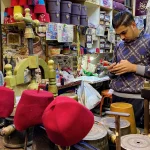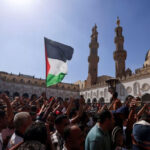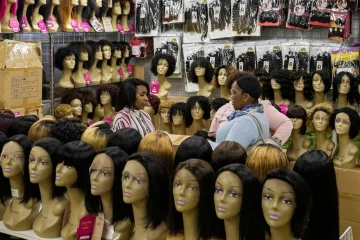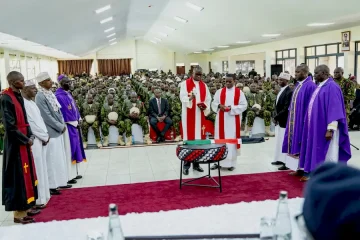MUHAMMAD El-Baset jumps up from his chair to meet a customer who has walked into his shop. They exchange a few words before Mohammed takes the man’s fez, the flat-topped, conical red hat that was once ubiquitous in Egypt, across North Africa and in the Middle East.
Even though the fez gets its name from the Moroccan city of Fez, home to a crimson-coloured berry used to create the dye that gives fezzes their vivid red colour, the hat has been a part of Cairo’s identity and culture for generations. El-Baset is determined to keep it that way.
“This is not just my livelihood and the story of my family, it is a source of pride for me. It has made me the man I am, hardworking and invested in keeping Cairo’s rich heritage alive for future generations,” he explained.
Inspecting the man’s tarboosh, as fezzes are called in Egypt, he trims its edges, then passes the hat to his brother Badr while turning his attention to a moulding machine, a one-plate gas stove and some levers.
A customer has come in to collect a hat while another five customers are waiting to get their hats stretched, trimmed, stitched and steamed back into shape. The brothers work diligently and silently. Every stitch and cut must be precise.
“Nothing can be out of place. A good-quality fez should last a lifetime,” Muhammad said.
The hats cost between US$7 and US$20, depending on the quality of the felt used. The brothers sell between 50 and 70 fezzes a month. It takes 30 minutes to create a new hat.
Their income is supplemented by selling jalabiyas (long-fitting robes worn across North Africa).
The men of the El-Baset family – Muhammad, Badr, and their father Nasser – are not just milliners. They are custodians of oral tradition and local history.
Cairo, home to the pyramids of Giza, some of the oldest and most splendorous mosques in Africa, and Al Azhar University – opened in 970 CE and still operational – is one of the most storied cities in Africa. It is possible to drink coffee at a cafe that dates back to 1797, dine at a restaurant that inspired Naguib Mahfouz, Egypt’s first recipient of the Nobel Prize for literature, shop at Khan el Khalili market that was established in the 14th century, and stroll down one of Cairo’s oldest streets, Al Moez, that brims with UNESCO World Heritage sites.
Just as it is known as the city of a thousand minarets, it can also be said that Cairo is a city of thousands of stories. Even the brother’s shop location in Old Cairo’s al-Ghoureya Street is a connection to the city’s past.
Fezzes were introduced to Egypt by the Ottoman Empire’s General Mohammed Ali Pasha when he became the country’s ruler in 1805. His grandson, Khedive Abbas I, made them the headgear of the day, worn by military officials, the political elite, religious leaders and scholars at Al Azhar University.
At the height of their popularity, there were 2,000 fez shops supporting families like the El-Basets. It was common to sell up to 500 fezzes daily. Even French designer Coco Chanel was a fan and famously bought 2,000 hats.
They fell out of style in 1952 when President Gamal Abdel Nasser banned them. He considered them a symbol of the Ottoman Empire’s colonial ruling class.
However, Muhammad and his family are determined to keep the tradition alive. His father operated the shop for more than 40 years after inheriting it from his father. Every interior wall is a tribute to the store’s iconic status, with any surface not occupied by newspaper and magazine articles about Nasser and the shop pasted over by pictures of Nasser with some of his clients and their business cards.
There are bamboo moulds stacked next to and under tables and shelves and rows and rows of ready-made fezzes.
Muhammad has been coming to the store ever since he was six years old, initially coming almost every day after school to watch his father work.
Every step of making a hat is the same from the beginning, when a client’s head is measured, to the end, when tassels are added to complete the hat. After taking measurements, bamboo is woven into the structure of the hat, then stretched into shape using copper moulds.
There is always water on hand to spray the bamboo.
“This makes it easier to work with,” Muhammad explained.
The hat gets a silk lining once in a conical shape. Meanwhile, the felt is pulled and steamed into shape, then smeared with glue before it’s bound to the bamboo. Silk tassels are added as the final touch.
There are three types of fezzes at Nasser Fez; the azharaa which is named after and worn by religious leaders at Al Azhar University and mosque, the qari and the effendi.
Today, it’s mostly imams and students from Al Azhar, a stone’s throw from the Nasser Fes, who wear fezzes.
The rest of society stopped wearing them after President Gamal Abdel Nasser banned them in the 1950s, and although they are coming back into style, it is cheaper to buy the mass-produced souvenirs imported from Asia; that are sold to tourists or worn by waiters in restaurants at Khan el Khalili market to create an authentic Egyptian aesthetic.
Featured in Business Insider in 2021, the reputation of the brothers and their shop simply keeps growing.
“People say this (making fezzes) is dying but I don’t think so. People come from different parts of the world to meet our family and see our work,” Mohammad said.
He makes sure all visitors leave with several hats.























